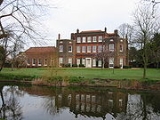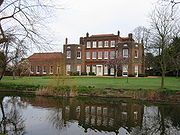
Langtons
Encyclopedia


Hornchurch
Hornchurch is a large suburban town in England, and part of the London Borough of Havering. Hornchurch is in North-East London .It is located east-northeast of Charing Cross and is one of the locally important district centres identified in the London Plan. It comprises a number of shopping...
in the London Borough of Havering
London Borough of Havering
The London Borough of Havering is a London borough in North East London, England and forms part of Outer London. The principal town in Havering is Romford and the other main communities are Hornchurch, Upminster and Rainham. The borough is mainly characterised by suburban development with large...
, east London.
The house, built on the foundations of an older house in the early 18th century, stands in a picturesque landscaped garden with a lake, orangery
Orangery
An orangery was a building in the grounds of fashionable residences from the 17th to the 19th centuries and given a classicising architectural form. The orangery was similar to a greenhouse or conservatory...
, bath house
Public bathing
Public baths originated from a communal need for cleanliness. The term public may confuse some people, as some types of public baths are restricted depending on membership, gender, religious affiliation, or other reasons. As societies have changed, public baths have been replaced as private bathing...
and a gazebo
Gazebo
A gazebo is a pavilion structure, sometimes octagonal, that may be built, in parks, gardens, and spacious public areas. Gazebos are freestanding or attached to a garden wall, roofed, and open on all sides; they provide shade, shelter, ornamental features in a landscape, and a place to rest...
, all dating from the end of the 18th century, when Hornchurch, Essex, was a rural suburb of London. The house was purchased in 1797 by John Massu, whose family, originally Huguenot
Huguenot
The Huguenots were members of the Protestant Reformed Church of France during the 16th and 17th centuries. Since the 17th century, people who formerly would have been called Huguenots have instead simply been called French Protestants, a title suggested by their German co-religionists, the...
refugees, had become wealthy silk merchants in the City of London
City of London
The City of London is a small area within Greater London, England. It is the historic core of London around which the modern conurbation grew and has held city status since time immemorial. The City’s boundaries have remained almost unchanged since the Middle Ages, and it is now only a tiny part of...
. He set about modernizing Langtons, to which he added the two-storey wings that project on the south front, and landscaping the grounds according to plans of Humphrey Repton. He created the serpentine pond with the bathhouse and gazebo
Gazebo
A gazebo is a pavilion structure, sometimes octagonal, that may be built, in parks, gardens, and spacious public areas. Gazebos are freestanding or attached to a garden wall, roofed, and open on all sides; they provide shade, shelter, ornamental features in a landscape, and a place to rest...
and planted horse chestnuts to mask or frame the mid-18th century stables, to which he added an octagonal cupola. A shrubbery
Shrubbery
A shrubbery is a wide border to a garden where shrubs are thickly planted; or a similar larger area with a path winding through it. A shrubbery was a feature of 19th-century gardens in the English manner, with its origins in the gardenesque style of the early part of the century...
walk with serpentining paths was planted east of the house and a balancing shrubbery belt to the west are probably part of Repton's plan; the Cedar of Lebanon was planted as a central feature of the lawn. By 1805 the gardens were sufficiently advanced to be illustrated in Peacock's Polite Repository.
Langtons was given to Hornchurch Urban District
Hornchurch Urban District
Hornchurch was a local government district in south west Essex, England from 1926 to 1965. The urban district council was based at Langtons House. The district formed a suburb of London and was expanded in 1934...
Council by Varco Williams and his daughter in 1929, under the condition that the building must be kept as it was and used for council purposes and that the six acres (24,000 m²) of grounds remain open to the public. The gardens, one of the
surviving historic landscapes serve as one of the parks and open spaces in Havering
Havering parks and open spaces
The London Borough of Havering is a London borough in northeast London, England. Part of Outer London, much of its area is protected from development by the Metropolitan Green Belt and more than half the borough is now parkland...
. Fielders Sports Ground, north of the site, was once also part of the gardens. The building housed the council offices until the council was abolished in 1965 and Havering London Borough Council, based in Romford
Romford
Romford is a large suburban town in north east London, England and the administrative headquarters of the London Borough of Havering. It is located northeast of Charing Cross and is one of the major metropolitan centres identified in the London Plan...
, was created.
It now houses a registry office with function rooms and has become a popular venue for wedding
Wedding
A wedding is the ceremony in which two people are united in marriage or a similar institution. Wedding traditions and customs vary greatly between cultures, ethnic groups, religions, countries, and social classes...
s. Due to an administration error the registry office was found to be unlicenced from October 2004 to March 2005 with around 80 marriages affected. Despite the error, all were later found by the High Court
High Court of Justice
The High Court of Justice is, together with the Court of Appeal and the Crown Court, one of the Senior Courts of England and Wales...
to be legally valid.

